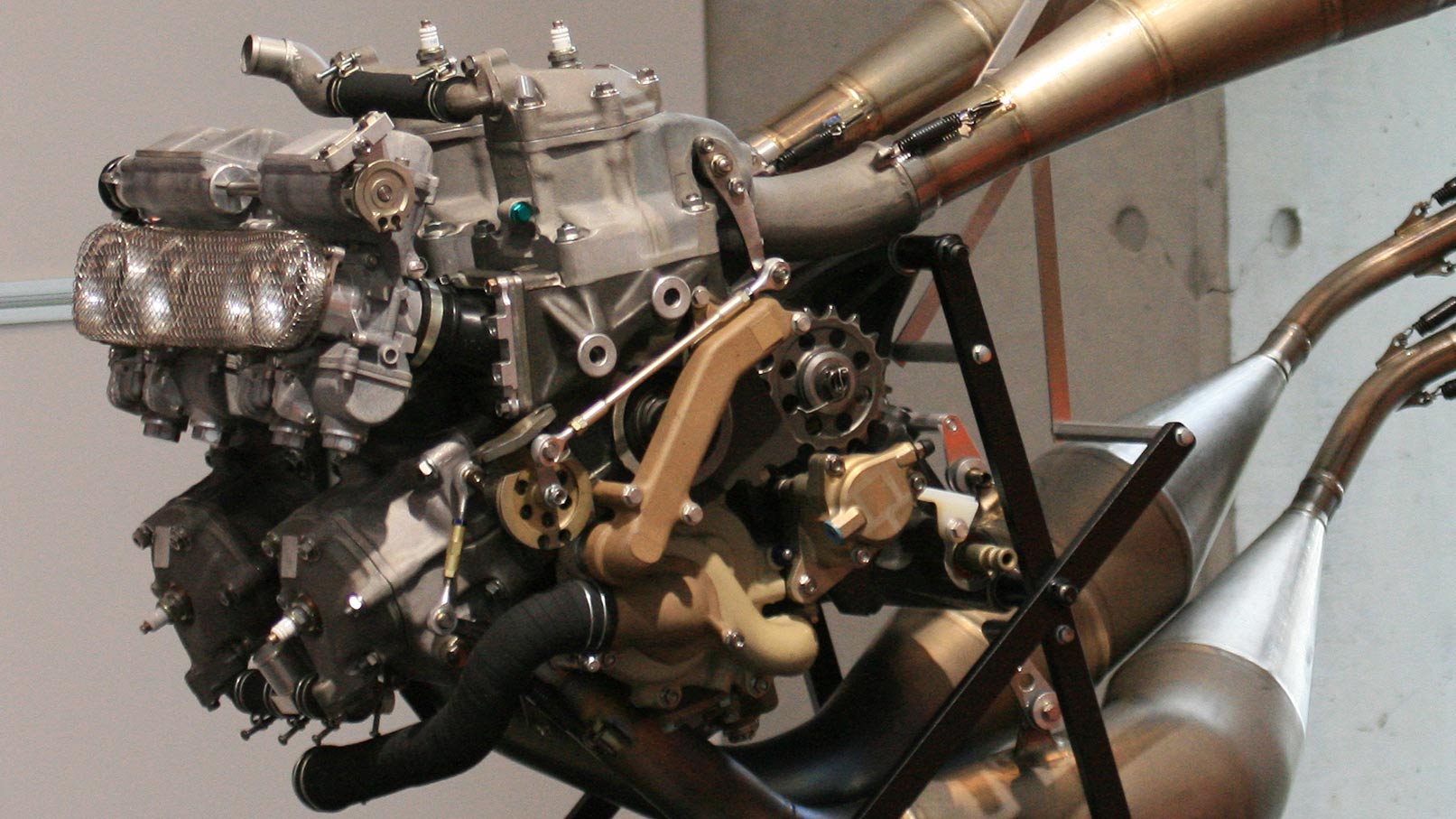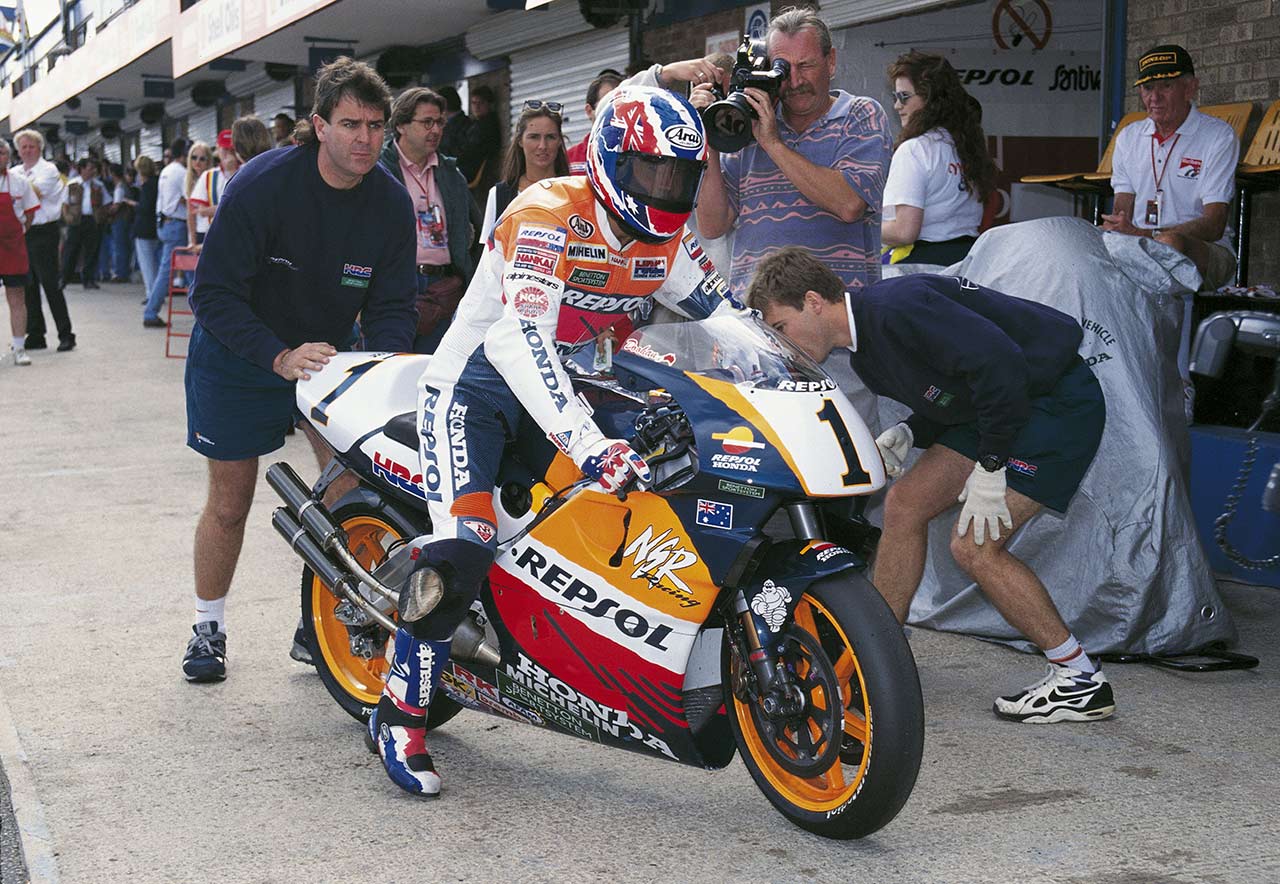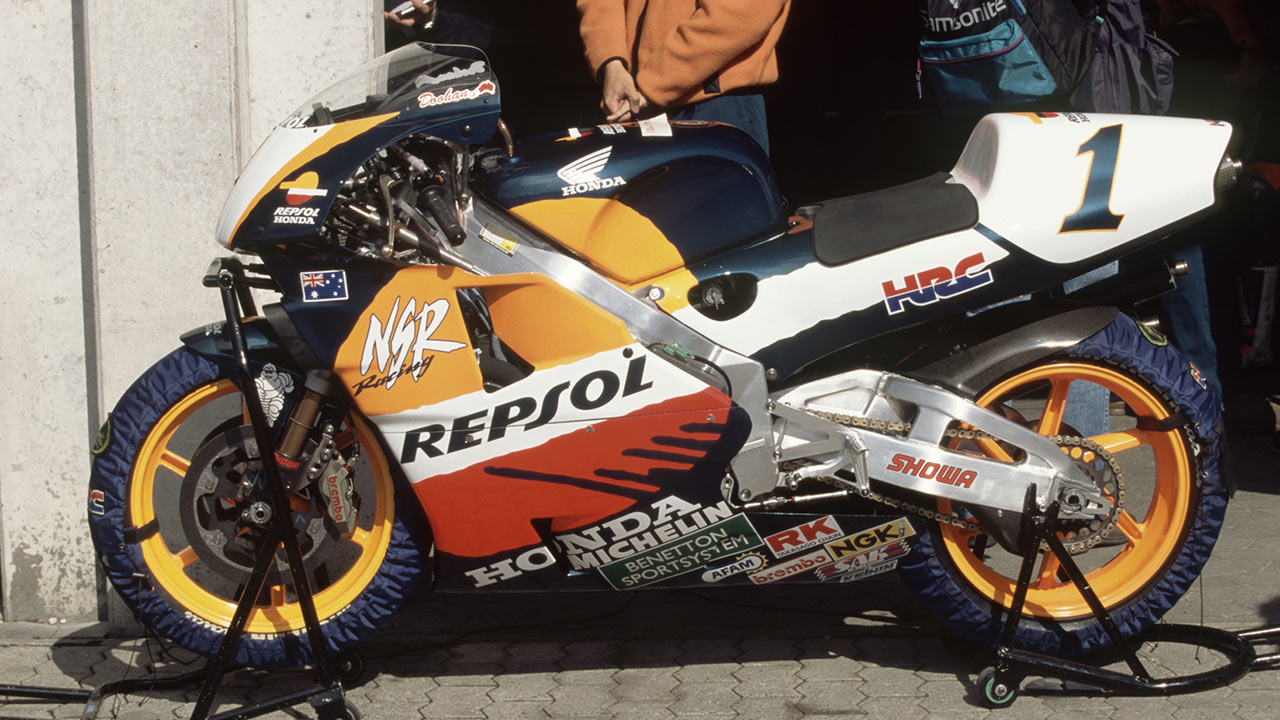In 1995, when the Repsol Honda Team began racing in the top class, the bike rode by Mick Doohan, Àlex Crivillé, and Shinichi Ito was the Honda NSR500. Released in 1984, it was the direct descendent of the champion NS500. This bike garnered five World Championships with the team, four of them for Doohan and another for Crivillé.
More recently, in 2012 to be exact, Honda presented the RC213V, the latest generation of MotoGP bikes, with which it has won six World Championships, all of them with Marc Márquez at the helm.
So, there are clearly two bikes at the top tier of racing, but what specifically differentiates them? Read on to find out!
Differences Honda NSR500 and Honda RC213V
Engines
The heart of any bike is the engine, and the Honda NSR500 and RC213V have V4 engines, liquid cooling, and six-speed transmission. That’s practically all that these two bikes have in common.


The NSR500 engine had a two-stroke 499cc unit whose four cylinders were in 112° V formation. In 1995, the engine was able to exceed 12,000 revolutions per minute and had 190 horsepower. Although it had an electronic injection system developed years earlier, the intake used ended up being with 39 mm carburettors.
The RC213V engine, on the other hand, is a four-stroke four-cylinder 1,000cc engine and its four cylinders are in a 90° V formation. It is capable of exceeding 17,000 revolutions per minute and has over 250 horsepower. Its injection system is extremely efficient and, with the pneumatic valve system, it is able to extract maximum performance out of every drop of fuel.
Although the transmissions on both bikes have the same number of speeds, the gearboxes work differently. The NSR500 had a conventional gearbox that was later coupled with a quickshifter system that allowed for speed increase without riders having to let go of the throttle or put in the clutch. That was not the case with slowing down, however.
The RC213V, on the other hand, has a seamless gearbox, which, thanks to its ingenuous design and electronics, can upshift and downshift without the clutch and without releasing the accelerator. On these bikes, the clutch is only activated at the starting line.


Both bikes have two of the most well-known firing orders in racing, the screamer and the big bang, which smooth power delivery to the engine or enhance performance, according to the circumstance.
Chassis and suspension
The chassis is the structure that holds up all the bike’s parts. The engine, fork, rear swingarm, seat, and panel are all anchored to it. The force leveraged by all the components and the movement of the bike create torque and cause bending in multiple directions. That’s why the chassis has become one of the key parts in bike design.
The 1995 NSR500 had a double-beam aluminium chassis developed by HRC. The engine was between the two beams and the swingarm was made of aluminium.
The RC213V sticks to its roots, maintaining the same type of chassis, albeit fully redesigned, achieving optimum balance between stability in straight-aways and performance in curves with steep inclines.
The bikes’ suspensions follow a similar pattern.
The NSR500 had a Showa inverted fork and a Showa pro-link rear suspension system as well. Both of these systems are fully adjustable. The material selected for the manufacture of these components was aluminium.


The RC213V has practically the same configuration, although in this case the manufacturer is Öhlins and the materials now include carbon fibre, both in the cartridge forks and in the rear swingarm.
Tyres and brakes
Both the NSR500 and the RC213V have the same size rims (17 inches, though until a few years ago the size used in MotoGP was 16.5 inches). Something that has indeed changed, however, is tyre technology, as today’s tyres are much higher quality and offer much better performance allowing them to function at more extreme angles of inclination.
The tyre distribution system has also changed. Twenty-two tyres are now given out per rider per GP for dry sessions; that’s a bit more than 400 tyres per year, while in 1995, more than 500 were allocated to riders per season and there were also fewer challenged races.


When it comes to the brakes, in 1995, the NSR500 had 320 mm carbon discs. The RC213V also has carbon discs, albeit a more modern version of them. It even has options of varying weights and thicknesses. Current regulations allow the use of 320 and 340 mm discs on all circuits, except MotoGP, where 340 mm discs are required.


One of the biggest benefits of the modern carbon brakes installed in the RC213V is that they can be used in rainy and cold conditions, something that was unthinkable only a few years ago.
Aerodynamics
One of the aspects of the current RC213V is its striking panelling, where you can find additions and shapes that were not available on the NSR500.
Although until recently bike lines were clean and quite similar to those of the 1990s, starting around 2015, we began to witness an aerodynamics revolution.


Modern bikes have surfaces especially-designed to create aerodynamic support in the front end during braking and accelerating while hardly affecting the bike’s performance in curves.
This has allowed the power of the engine to be leveraged even more as it helps minimise the occurrence of wheelies and allows for later braking in exchange for a slight reduction in maximum speed. This is sometimes scarcely noticeable given the power of these bikes.


Both bikes are also quite similar in size. While the NSR500 measured 1,950 mm and had 1,350 mm between axles, the RC213V is a bit larger at 2,050 mm long and 1,435 mm between axles. The modern bike is slightly taller as well at 1,110 mm compared to the 1,080 mm of the NSR; it is also wider at 645 mm compared to the 600 mm of the 1995 bike. These small differences would entail a significant handicap on the bike’s performance if it weren’t for its well-executed aerodynamics.
Electronics, the modern ally
In 1995, bikes already had electronic components installed to improve their performance. Components like exhaust valves and programmable electronic ignition were already included, but only the rider’s skill and the configuration of the engine could control these engines’ power delivery.


With the arrival of four-stroke MotoGP bikes, electronics took on a much bigger role, which has only grown in recent years.
The RC213V has a few dozen sensors responsible for checking everything from the suspension position to the pressure in the pneumatic valve system, as well as the inclination or acceleration of the bike. All of these electronics communicate with an advanced switchboard able to make various calculations per second to optimise the bike’s performance based on the needs of the situation and the rider’s wishes, as they control the different options available from the handlebars.


Without the help of these electronics, motorcycles would practically be “wilder” than the NSR500.
Performance on the track
With all of the technological advances available today, especially thanks to electronics, light materials such as magnesium, and next-generation materials like carbon fibre, in most cases, bikes have achieved seconds-faster lap times compared to the early years.


Not only have times improved, but, even though riders do practically the same number of laps around tracks with a lot more power, consumption has dropped significantly. NSR500s had 32-litre tanks, while the RC213V have 22-litre tanks.
Maximum speed has also increased. NSR500 had a max close to 320 km/h, while RC213V now go over 350 km/h.
Interestingly enough, there is one thing that the RC213V beats the NSR500 at, and that is weight. The two-stroke model weighed 130 kg, while the current Repsol Honda Team frame must weigh at least 157 kg as per regulations.


With cutting-edge electronics and engines, the RC213V is a bike that will far outperform the NSR500, but these differences are the result of decades of evolution.
Both bikes were a watershed for the world of racing and have left us with many fond memories. And they will continue to do so.


 Join Us
Join Us  Join Us
Join Us 